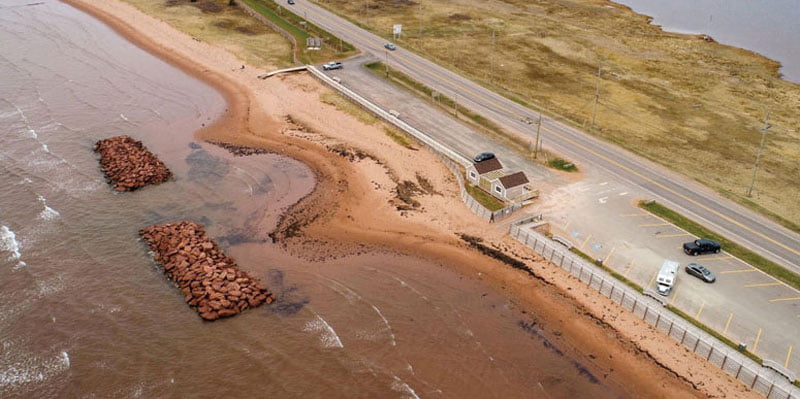
Using Nature-based Solutions to Enhance Coastal Protection
By Joanna Eyquem
Coastal flooding and erosion are a direct threat to the health and safety of people living in coastal communities, and cause damage to local infrastructure and property. The majority of Canada’s coastal population is located along the East (Atlantic) and West (Pacific) coastlines, where sea levels are rising due to irreversible climate change.
Action is required NOW to manage the growing risks to coastal communities. A recent report from the University of Waterloo’s Intact Centre describes how Canada can scale-up the use of nature-based solutions, in tandem with ‘grey’ infrastructure, to protect communities along the East and West coastlines. Importantly, action must consider natural processes along the coast to a greater extent than has occurred to date. Reduction of flooding and erosion at one site, if not carefully designed, can cause instability further along the coast and degradation of coastal ecosystems on which communities depend.
Canada does not yet have a strategic planning framework or standard classification of approaches for coastal risk management. Coastal risk management responses identified by the Intergovernmental Panel on Climate Change (IPCC) include Protection, Accommodation, Retreat and Avoidance, as well as non-intervention.
A suite of options should be appraised to select appropriate approaches along Canada’s east and west coasts. Coastal protection measures can be divided into two key categories:
• Grey Infrastructure: hard, engineered coastal protection measures, and; Nature-Based Solutions: measures that depend on, or mimic, natural systems to manage flood and erosion risk, Nature-based solutions are further subdivided into those that are:
- Predominantly sediment-based, such as adding sediment or sand to beaches (a process known as beach nourishment)
- Predominantly vegetation-based, such as saltmarsh or coastal wetland restoration.
- Nature-based solutions, in particular, have a vital role to play in managing coastal flood and erosion risk in Canada. International experience and guidance demonstrate that these measures not only provide protection against coastal flooding and erosion, they also deliver multiple benefits, including improved biodiversity, carbon sequestration and storage, enhanced wellbeing and opportunities for recreational activities.
Three courses of action are recommended to scale-up the use of nature-based solutions for coastal protection in Canada:
• Develop national standards to support consistent evaluation of the benefits of nature-based solutions when comparing infrastructure options, including for coastal protection. This should include minimum requirements, regional-specific standards, engagement with Indigenous people and recommended methodologies for reflecting the financial value of benefits provided by nature-based solutions.
• Develop national monitoring standards for coastal protection measures, focused on nature-based solutions. This should include combining Natural and Grey Infrastructure to Protect Canada’s coastal communities; consideration of minimum monitoring requirements, as well as how monitoring should be tailored to document performance against project-specific objectives (funding for long-term monitoring and engagement with Indigenous people could be considered as minimum monitoring requirements).
• Build capacity to finance and deliver nature-based solutions by engaging the private sector. Public private partnerships can potentially assist in financing, delivering, monitoring, and maintaining nature-based solutions. The insurance industry can also assist in managing construction risks and offering innovative insurance products that provide funds to restore natural features protecting the coastline, should they be damaged during extreme events.
The outcomes of these actions will help governments and other organizations make robust management decisions regarding coastal flooding and erosion along Canada’s coastlines.
Perhaps the greatest challenge in Canada, and globally, in preparing for climate change and sea-level rise along the coast, is a limited sense of urgency to act. For around the past 6,000 years, global sea-level has remained relatively steady.
This makes the recent, comparably rapid rise in sea-level caused by human-induced climate change less easy to grasp. Decision makers in Canada must realize, sooner rather than later, that the sea level of the past will not be the sea level of the future, and prepare coastal communities accordingly.
Joanna Eyquem P.Geo. ENV SP. CWEM. CEnv., is Managing Director, Climate-Resilient Infrastructure at the Intact Centre on Climate Adaptation, Faculty of Environment, University of Waterlo. joanna.eyquem@uwaterloo.ca
SUBSCRIBE TO THE DIGITAL OR PRINT ISSUE OF SABMAGAZINE FOR THE FULL VERSION OF THIS ARTICLE.
